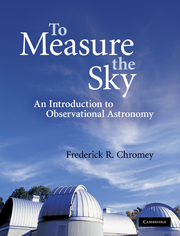7 - Matter and light
Published online by Cambridge University Press: 05 June 2012
Summary
Because atomic behavior is so unlike ordinary experience, it is very difficult to get used to, and it appears peculiar and mysterious to everyone – both to the novice and to the experienced physicist. Even experts do not understand it the way they would like to, and it is perfectly reasonable that they should not, because all of direct human experience and of human intuition applies to large objects.
– Richard Feynman, The Feynman Lectures on Physics, 1965Chapter 1 introduced the situations that produce line and continuous spectra as summarized by Kirchhoff's laws of spectrum analysis. This chapter descends to the microscopic level to examine the interaction between photons and atoms. We show how the quantum mechanical view accounts for Kirchhoff's laws, and how atomic and molecular structure determines the line spectra of gasses.
To understand modern astronomical detectors, we also turn to a quantum mechanical account – this time of the interaction between light and matter in the solid state. The discussion assumes you have had an introduction to quantum mechanics in a beginning college physics course. We will pay particular attention to some simple configurations of solids: the metal oxide semiconductor (MOS) capacitor, the p–n junction, the photo-emissive surface, and the superconducting Josephson junction. Each of these is the physical basis for a distinct class of astronomical detector.
- Type
- Chapter
- Information
- To Measure the SkyAn Introduction to Observational Astronomy, pp. 196 - 234Publisher: Cambridge University PressPrint publication year: 2010

